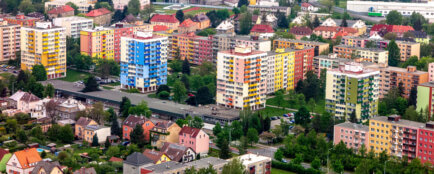What is a zoning plan
Spatial planning has a long history that goes back to ancient civilisations, such as ancient Roman town plans. However, modern spatial planning evolved in response to the Industrial Revolution of the 19th century.
The rapid development of cities and industrial centres created the need for organised planning and regulation of the growth and development of urban areas. The poor sanitary conditions of overcrowded cities – congested accommodation and work areas, inadequate water and wastewater infrastructure and poor air quality – played a key role.
A municipal spatial plan is a document that determines how a municipality’s territory will be used and developed in terms of urban planning, infrastructure, environmental protection, etc. It is a strategic plan that sets out zones for different types of use (residential, industrial, agricultural, etc.), transport infrastructure, green spaces, nature conservation and other elements.
What you can find in the spatial plan
The spatial plan consists of a text part, which contains legal provisions and conditions, and a graphic part, which shows the delineation of the different zones and their functional use on maps. The graphic part is key to the visual interpretation of the plan and its application in practice.
In particular, it provides a categorisation of all areas and their possible uses. Areas can be either stable areas, where the use has not changed since the last master plan, or areas of change, where a change from existing use to new uses is planned.
You may come across terms such as, are areas of mixed residential – rural, where you can build a family house under certain conditions. However, you often have to meet certain criteria regarding construction – for example, houses cannot be built in a row, houses cannot have more than two storeys or must have a gable roof.
Are you solving a similar problem?
Has there been a zoning change that you disagree with?
Contact an available attorney. We will find out what your legal problem is and propose a solution, including a fixed price. You will receive a proposal and quote within 24 hours and if you use our services to solve your problem, we will refund your fee.
I want to help
- When you order, you know what you will get and how much it will cost.
- We handle everything online or in person at one of our 6 offices.
- We handle 8 out of 10 requests within 2 working days.
- We have specialists for every field of law.
The municipality also designates shared spaces. These can be, for example, areas of technical infrastructure mapping the location of utilities or areas of public spaces where you can find a municipal park.
An important part of the master plan is the justification for the master plan, which includes the reasons for issuing the plan, an analysis of relevant factors, and the considerations that led to its formulation. It also includes an assessment of environmental impacts, economic impacts, etc.
Why is the land use plan important
You should be interested in the spatial plan for several reasons:
- Changes around you: the spatial plan will give you an insight into the future of your neighbourhood. It will give you an insight into what will happen to that abandoned lot behind your house or whether a new park will be built near you.
- The value of your property: a zoning plan can dramatically change the value of your property. If areas of transport infrastructure, for example, appear behind your house, this is likely to lead to a sharp drop in price, because nobody wants to live on a busy road. Conversely, if you find an area of amenities where the municipality plans to build a sports ground and a new school, the price is likely to rise.
- Buying a property: if you have a plot of land in mind, be sure to look at the master plan. This is superior to the land registry. Thus, in the cadastre it may be arable land, while in the zoning it may be mixed residential land.
- Building a house: If you are going to build a house, again be sure to consult the zoning plan. This is often quite specific as to what building on the site can look like. This will help you avoid having an expensive project rejected.
Tip for article
Tip: Are you planning to build? Learn how to properly submit a building application.
The importance of the master plan can be easily illustrated by an example:
Mr. Novak lived happily in a small family house in a quiet residential area on the outskirts of the city. At the time he bought the house, there was a zoning plan in place that designated the area as mixed residential. The neighborhood was mostly single-family homes and green spaces.
One day the city decided to change the zoning of this part of town. The new plan allowed a new shopping center to be built right next to Mr. Novak’s house. The brand new shopping center disrupted Mr. Novak’s happy living in many ways.
First and foremost, it attracted more people, traffic in the neighbourhood increased and the overall atmosphere of the residential area was negatively transformed – the quiet suburb became one of the busiest places in the city. Mr Novák had to deal with traffic jams and increased noise from the traffic and parking lots of the new shopping centre. Quiet evenings in the garden became passé.
On the other hand, the zoning change may also look like this:
Mrs Novotná lived in an old block of flats surrounded by concrete and adjacent to a disused factory. The city’s new master plan decided to revitalize this part of town, converting the old factory into a school and building two parks.
The new green areas and the school attracted new residents and businesses, which changed the overall character of this part of town. Mrs. Novotna was able to enjoy not only the new parks right in front of her apartment, but also the many new services and opportunities.
Tip for article
Do you disagree with the changes in the zoning plan? Have these changes directly affected your land or neighbourhood and are you worried that they will make your life much more difficult? Find out how to defend the zoning plan.
Where to look for a zoning plan
The municipality’s zoning plan is a public document and can usually be found on the municipality’s website. If you can’t find it online, you can contact the municipality directly and they will give you access to the current version of the master plan. In addition, it is also available at the regional office under which the municipality falls, at the building office or at the planning office.
Spatial development principles and regulatory plan
The spatial development principles and the regulatory plan also have an influence on the form of a specific land use plan.
Development principles
The spatial development principles are created at the level of the region. It is therefore the overarching document that municipalities in a given region must follow when developing their land use plans. It differs from the spatial plan in that it is much more general, thus creating room for specification within individual spatial plans.
Their purpose is therefore to coordinate and roughly set the development of individual municipalities, to plan infrastructure that extends beyond individual municipalities, possibly linking to other counties (e.g. new roads passing through several municipalities to a neighbouring county) and various public utility structures extending beyond individual municipalities. It also aims to preserve the cultural and historical values of the region. The spatial development principles also include an assessment of the impact on sustainable development. The latter consists, in particular, in the protection of the environment, the economic development of the region and the overall cohesion of the local population.
Tip for article
Tip: Planning to buy a property? We will provide you with a complete contractual and legal service. We can do it within 48 hours, flawlessly and professionally.
Regulatory plan
While the spatial development principles stand above the master plan, the regulatory plan is a subset of it. The Regulatory Plan further specifies how to deal with a certain part of the territory of a given municipality. It is therefore more detailed than a zoning plan.
The basic unit is the land. You will therefore find specific plans for the use of particular plots of land – for example, the exact location of buildings and their layout. You can therefore find drawings of buildings on specified plots, their orientation and purpose (e.g. the upper floor of a building will be residential and the lower floor will be used as commercial space).
Its aim is usually to preserve the characteristic features of the buildings in a given location and to coordinate the technical and transport infrastructure in the defined area. The principles of environmental protection, economic development and preservation of cultural and historical values also apply here.
Tip for article
You can also find out how a local referendum works, what the rules are and who can call it.
Summary
The Township’s land use plan determines how the Township’s land will be developed and used. It establishes zones for different types of uses, including residential, industrial or greenfields, and transportation infrastructure. It consists of a text section with legal provisions and a graphic section with maps detailing the use of each area.
The zoning plan affects property prices and can significantly change the surrounding environment. It is a public document that is available at the municipal office or online. Important components include the Land Development Principles, which coordinate development within the county and protect cultural and historic values, and the Regulating Plan, which then details specific land uses and building layouts.




